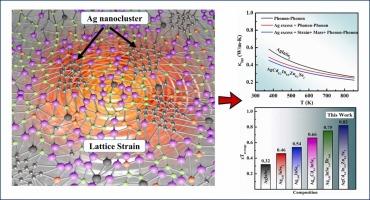Ultra-low thermal conductivity and high zT in multi-doped AgInSe2: A high-entropy approach to n-type thermoelectric materials
IF 17.1
1区 材料科学
Q1 CHEMISTRY, PHYSICAL
引用次数: 0
Abstract
The escalating global energy demand and the need for sustainable energy solutions highlight the importance of advancing thermoelectric technologies for efficient waste heat recovery and refrigeration. Although diamond-like chalcogenides are promising high-performance thermoelectric materials, the development of high-efficiency n-type counterparts remains a major challenge. This study introduces a multi-doping approach to synthesize high-entropy diamond-like chalcogenides AgxCdyIn1-zZnzSe2, achieving an ultra-low lattice thermal conductivity of 0.2 W/m.K at 800 K in AgCd0.2In0.9Zn0.1Se2.This is attributed to the formation of Ag-rich nanoclusters and strong phonon scattering induced by lattice strain and point defects. In parallel, carrier concentration is optimized through excess Ag and multi-doping, which enhances the power factor. As a result, a peak zT of 1.15 at 800 K and an average zT of 0.82 over 370–800 K are achieved, which represents the highest reported values for n-type diamond-like chalcogenides within this temperature range. In addition, a prototype thermoelectric module was fabricated by combining the developed n-type AgCd0.2In0.9Zn0.1Se2 with p-type Cu0.8Ag0.2[Ga0.8In0.2]0.99Zn0.01Te2. These results demonstrate the potential of high-entropy diamond-like chalcogenides for next-generation thermoelectric applications while also underscoring the need for further optimization of module integration.

多掺杂AgInSe2的超低导热率和高zT: n型热电材料的高熵方法
不断增长的全球能源需求和对可持续能源解决方案的需求凸显了推进热电技术对高效废热回收和制冷的重要性。虽然类金刚石硫族化合物是一种很有前途的高性能热电材料,但开发高效的n型化合物仍然是一个重大挑战。本研究采用多掺杂方法合成高熵类金刚石硫族化合物AgxCdyIn1-zZnzSe2,实现了0.2 W/m的超低晶格热导率。在AgCd0.2In0.9Zn0.1Se2中,K在800k。这是由于富银纳米团簇的形成和晶格应变和点缺陷引起的强声子散射。同时,通过过量银和多掺杂优化载流子浓度,提高了功率因数。结果表明,在800 K时zT峰值为1.15,在370-800 K范围内平均zT为0.82,这是在该温度范围内报道的n型类金刚石硫属化合物的最高值。此外,将开发的n型AgCd0.2In0.9Zn0.1Se2与p型Cu0.8Ag0.2[Ga0.8In0.2]0.99Zn0.01Te2结合,制作了热电模块原型。这些结果证明了高熵类金刚石硫族化合物在下一代热电应用中的潜力,同时也强调了进一步优化模块集成的必要性。
本文章由计算机程序翻译,如有差异,请以英文原文为准。
求助全文
约1分钟内获得全文
求助全文
来源期刊

Nano Energy
CHEMISTRY, PHYSICAL-NANOSCIENCE & NANOTECHNOLOGY
CiteScore
30.30
自引率
7.40%
发文量
1207
审稿时长
23 days
期刊介绍:
Nano Energy is a multidisciplinary, rapid-publication forum of original peer-reviewed contributions on the science and engineering of nanomaterials and nanodevices used in all forms of energy harvesting, conversion, storage, utilization and policy. Through its mixture of articles, reviews, communications, research news, and information on key developments, Nano Energy provides a comprehensive coverage of this exciting and dynamic field which joins nanoscience and nanotechnology with energy science. The journal is relevant to all those who are interested in nanomaterials solutions to the energy problem.
Nano Energy publishes original experimental and theoretical research on all aspects of energy-related research which utilizes nanomaterials and nanotechnology. Manuscripts of four types are considered: review articles which inform readers of the latest research and advances in energy science; rapid communications which feature exciting research breakthroughs in the field; full-length articles which report comprehensive research developments; and news and opinions which comment on topical issues or express views on the developments in related fields.
 求助内容:
求助内容: 应助结果提醒方式:
应助结果提醒方式:


